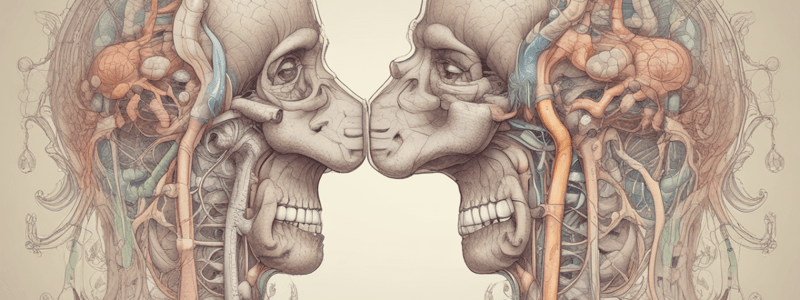Podcast
Questions and Answers
What type of epithelium lines the posterior glottis?
What type of epithelium lines the posterior glottis?
- Pseudostratified ciliated epithelium (correct)
- Cuboidal epithelium
- Stratified squamous epithelium
- Simple columnar epithelium
What is the function of the epiglottis?
What is the function of the epiglottis?
- To facilitate breathing
- To produce sound
- To prevent food from entering the respiratory system (correct)
- To support the trachea
What type of cartilage supports the larynx?
What type of cartilage supports the larynx?
- Fibrocartilage
- Hyaline cartilage (correct)
- Elastic cartilage
- Cartilaginous cartilage
What is the characteristic of the submucosa layer in the trachea?
What is the characteristic of the submucosa layer in the trachea?
What is the difference between the bronchus and bronchiole?
What is the difference between the bronchus and bronchiole?
What type of cells line the bronchioles?
What type of cells line the bronchioles?
What type of muscle is found in the vocal cords?
What type of muscle is found in the vocal cords?
What is the function of pneumocyte type II cells?
What is the function of pneumocyte type II cells?
What is the function of the nasopharynx?
What is the function of the nasopharynx?
What type of epithelium lines the trachea?
What type of epithelium lines the trachea?
What is the cause of hyaline membrane disease?
What is the cause of hyaline membrane disease?
What is the effect of asthma on the bronchioles?
What is the effect of asthma on the bronchioles?
What is emphysema characterized by?
What is emphysema characterized by?
What is the effect of squamous metaplasia on the bronchial epithelium?
What is the effect of squamous metaplasia on the bronchial epithelium?
What is the function of pneumocyte type I cells?
What is the function of pneumocyte type I cells?
What is the percentage of alveolar wall cells that pneumocyte type II cells represent?
What is the percentage of alveolar wall cells that pneumocyte type II cells represent?
Flashcards are hidden until you start studying
Study Notes
Pharynx and Larynx
- Nasopharynx is the posterior continuation of nasal cavities and becomes continuous with the oropharynx at the level of the soft palate.
- Larynx connects the pharynx with the trachea.
- The wall of the larynx is supported by hyaline cartilage and striated muscle (skeletal muscle).
- Vocal cords consist of skeletal muscle (vocalis muscle).
- Anterior glottis is covered with Stratified squamous epithelium, posterior glottis is covered with pseudostratified ciliated epithelium.
Epiglottis and Trachea
- Epiglottis closes off the trachea to prevent inhalation of solids or liquids.
- Epiglottis is made of elastic cartilage.
- Trachea has mucosa with pseudostratified ciliated columnar epithelium with goblet cells.
- Submucosa is a connective tissue layer with many seromucous glands.
- Hyaline cartilage is present in the trachea.
- Adventitia contains dense connective tissue.
Bronchus and Bronchiole
- Bronchus has a short lumen, lined with pseudostratified ciliated columnar epithelium.
- Bronchiole has a long lumen, lined with ciliated columnar cells, Clara cells, and present mucoserous glands.
Alveoli and Pneumocytes
- Pneumocyte type I represents 97% of alveolar wall cells, has a cuboidal shape, and forms part of the blood-gas barrier.
- Pneumocyte type II represents 3% of alveolar wall cells, has a rounded shape, and secretes surfactant to decrease surface tension of alveoli.
Respiratory Diseases
- Hyaline membrane disease occurs in those who lack adequate amounts of pulmonary surfactant, causing labored breathing.
- Asthma is a constriction of smooth muscle in bronchioles, causing decreased diameter and dyspnea.
- Emphysema is the destruction of alveolar walls and formation of large cyst-like sacs, reducing surface area available for gas exchange.
Studying That Suits You
Use AI to generate personalized quizzes and flashcards to suit your learning preferences.




